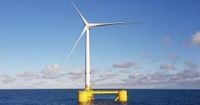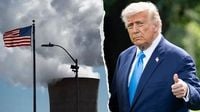On August 29, 2025, the Trump administration delivered a seismic blow to America’s clean energy ambitions, abruptly halting the nearly completed Revolution Wind project off the coast of Rhode Island. This move, just one in a series of actions targeting the renewable sector, has ignited fierce debate over the future of U.S. energy policy and its place in the global race for technological leadership.
According to Foreign Policy, the decision to stop Revolution Wind is emblematic of a broader rollback. The Trump administration has systematically dismantled wind and solar initiatives championed by its predecessor, instead doubling down on fossil fuels in a bid for what it calls “American energy dominance.” The U.S. remains the world’s largest oil producer and a major exporter of natural gas, and the administration’s priorities reflect that legacy. But critics argue this is a backward-looking strategy, ceding the industries of tomorrow to foreign competitors—chief among them, China.
“The Biden administration put climate at the center of its energy policy and took a very transition-forward stance,” observed Kevin Book, managing director at ClearView Energy Partners, in remarks to Foreign Policy. “The Trump administration is largely running the playbook in reverse.”
China, meanwhile, is sprinting ahead. Despite being the world’s largest coal consumer and carbon emitter, Beijing has invested more than $50 billion in new photovoltaic supply capacity—ten times Europe’s investment, per the International Energy Agency. China now controls over 80 percent of the global solar panel supply chain and produces more than three-quarters of all batteries sold worldwide. In 2023, it accounted for 65 percent of global wind capacity, and its dominance in battery technology underpins both the electric vehicle (EV) revolution and critical military systems.
“At this point in time, the Chinese side has established a significant and irreversible lead vis-à-vis their U.S. competitors,” said Li Shuo, director of the China Climate Hub at the Asia Society Policy Institute, in an interview with Foreign Policy. “The gap between the two countries will only be widened based on Trump’s policies.”
This widening chasm is not just a matter of prestige. In 2024, emerging markets accounted for 43 percent of China’s clean tech exports, nearly double their share from just two years earlier, according to BloombergNEF. Pakistan, for instance, more than doubled its solar panel imports from China in a single year, and African imports of Chinese solar panels jumped 60 percent between July 2024 and July 2025, with South Africa and Nigeria leading the way, as reported by Ember.
Chinese firms aren’t stopping at exports. They’re building EV and battery factories in countries as varied as Brazil, Hungary, Indonesia, Russia, Thailand, and Turkey. As Li Shuo put it, “At the end of the day, this will then be part of the story of China’s global expansion—its economic integration with some parts of the world.”
While some regions, notably Europe, have pushed back—European Commission chief Ursula von der Leyen warned against markets being flooded with “massively subsidized electric cars”—others are eager for affordable clean tech. The U.S., on the other hand, is moving in the opposite direction. Trump’s trade deal with the European Union this year included a $750 billion commitment for the EU to buy American oil and gas. In August, top administration officials threatened retaliation against countries supporting a global agreement to curb shipping emissions.
“From a purely competitive standpoint … it’s not clear that the U.S. can really prevent the rest of the world [from] becoming much more dependent on renewables and EVs and batteries,” said Ilaria Mazzocco, a Chinese climate policy expert at the Center for Strategic and International Studies, to Foreign Policy. “The risks are that the U.S. misses out on some of the technologies of the future.”
Domestically, the Trump administration’s policies have sent shockwaves through the clean energy sector. As Fortune reports, the removal of the $7,500 federal tax credit for EVs has caused demand to plummet, resulting in a surplus of batteries and a sharp decline in manufacturing investment. In 2024, battery manufacturing investments fell 80 percent from their 2022 peak, and the first quarter of 2025 saw a record $6 billion in cancelled projects. Freyr Battery, a notable clean-energy firm, scrapped plans for a $2.6 billion factory in Georgia, citing falling prices.
“It’s a combination of removal of the incentives, plus maybe a little stagnant interest from buyers, which is leading to lower demand,” said Willy Shih, a Harvard Business School professor, to Fortune. Only 19 percent of Americans surveyed by AAA in 2025 said they were likely to buy an EV as their next car—the lowest figure since 2019.
This battery glut, experts warn, is a double-edged sword. Matthew Hales, a BloombergNEF analyst, called the surplus and lack of government support “a poison pill for U.S. manufacturing hopes.” Li Chen of Cornell University described the situation as a “bullwhip effect”: declining demand leads to overcapacity now, but could cause shortages and price spikes later if producers scale back.
Meanwhile, China’s battery manufacturing capacity is three times the expected global demand for 2025, according to BloombergNEF. A price war among Chinese EV giants has further depressed battery prices, making it even harder for U.S. producers to compete. Shih summed it up bluntly: “Facing a demand fall-off is actually very bad for the long-term health of the U.S. manufacturing of batteries. And if you believe—as many people do—that batteries are a key technology as the world moves towards more electrification, that’s not a good scenario.”
Some battery producers are eyeing the solar industry as an alternative market. But the Trump administration’s hostility extends here as well. Earlier this month, it announced it would no longer approve new wind or solar projects, arguing that they increase energy prices. This stance, according to Shih, is shortsighted: “He looks at one thing at a time, as opposed to looking at the bigger picture.” The long-term cost of energy, he argued, could be lower if the U.S. invested in battery manufacturing and renewables.
On the political front, Trump’s actions have sparked outrage from Democrats and clean energy advocates. North Coast Representative Jared Huffman (D-Calif.) blasted the administration’s decision to kill funding for offshore wind projects, calling it “a new level of idiocracy” and accusing Trump of “trying to destroy an entire sector of clean energy, kill thousands of good paying jobs, and drive up electricity prices for American consumers.” Huffman argued that the administration is “surrendering the future to China by dragging America back to dirty, climate-wrecking fossil fuel dependency while most of the world is moving on to safer, cleaner, and cheaper clean energy.”
The Department of Transportation, for its part, defended the move. Secretary Sean P. Duffy announced the withdrawal or termination of $679 million in funding for 12 offshore wind projects, asserting that these projects were "wasteful" and that resources should be redirected to “real infrastructure improvements over fantasy wind projects that cost much and offer little.”
As the U.S. pivots away from renewables, experts warn that the consequences will be felt for generations. The technological and economic gap with China is growing, and America’s energy future—once poised to lead the world in innovation—now faces deep uncertainty. Whether the nation can regain its footing in clean energy remains an open question, but for now, the momentum has clearly shifted overseas.



